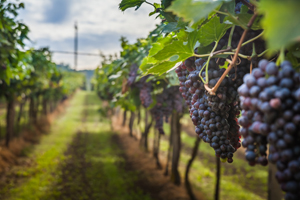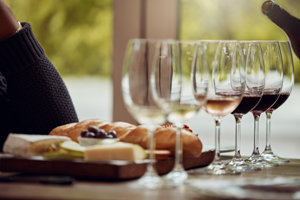the drunken cyclist
By Jeffrey M. Kralik, Ph.D.
www.thedrunkencyclist.com
With the kids back in school, it is time for a little adult education, some Wine 101.
I have been conducting wine tastings and wine education for the better part of two decades now, and some of the same questions come up repeatedly. Here are a few of those common queries with answers that might help you “pass” your next wine event.
Q: What is wine?
 A: That’s an easy one. Basically, any fermented fruit juice is considered wine, but the vast majority of wine (99%+) comes from fermented grapes. There are over 10,000 species of wine grapes, but only a couple dozen or so are widely available.
A: That’s an easy one. Basically, any fermented fruit juice is considered wine, but the vast majority of wine (99%+) comes from fermented grapes. There are over 10,000 species of wine grapes, but only a couple dozen or so are widely available.
Q: Why is there such a wide range of prices for wine? Are more expensive wines worth it?
A: Many factors go into the price of a bottle of wine, but by far the most significant is the cost of the fruit. In California, this can vary greatly, from a few hundred dollars per ton in the lesser-known regions, to as much as $20,000 per ton or more in Napa Valley. Why the huge difference? Part reputation, part “terroir,” which is, briefly, the quality of the environment where the grapes are grown (soil, climate, etc.). Other factors include whether the wine was aged in oak barrels, which can run as high as $2,000 per barrel.
As for “worth?” That is all in the tongue of the beholder. In my opinion, there are noticeable increases in quality with roughly every $10 augmentation in price (e.g., a $20 wine is usually noticeably “better” than a $10 bottle) up to perhaps $50 or $60. After that? While more expensive wines tend to be “better” than less expensive wines, the incremental change is less north of $50.
Q: Wine people seem like a pretty pretentious lot, always swirling their wine, sniffing the glass. Doesn’t it just smell like grapes?
 A: There is a lot to unpack here. First, I would agree that there is far too much pretentiousness in the wine world, but there are good reasons for all the swirling and sniffing. Generally speaking, the presence of oxygen in the production of wine is a bad thing as it causes the wine to age prematurely and can make the wine taste stale or dull. Once the wine is in the glass, however, oxygen is a very good thing as it helps the wine “open up” or “breathe” essentially releasing aromas and flavors. One of the best ways to get oxygen into the wine is to swirl it around a bit either in a glass or a decanter.
A: There is a lot to unpack here. First, I would agree that there is far too much pretentiousness in the wine world, but there are good reasons for all the swirling and sniffing. Generally speaking, the presence of oxygen in the production of wine is a bad thing as it causes the wine to age prematurely and can make the wine taste stale or dull. Once the wine is in the glass, however, oxygen is a very good thing as it helps the wine “open up” or “breathe” essentially releasing aromas and flavors. One of the best ways to get oxygen into the wine is to swirl it around a bit either in a glass or a decanter.
As for the sniffing, the human tongue can detect five basic “tastes:” sweet, sour, salty, bitter and umami (a savory meatiness found in soy sauce, mushrooms, aged steak, etc.). All other tastes actually come from the smells detected by the nose, which can discern around 10,000 different aromas. That is the reason that food tastes bland when you have a cold and causes you to over-salt or add more sugar, because those flavors can be detected by the tongue.
When it comes to discerning the aromas in wine, some are better than others. My older son is like the vast majority of the population; he smells a wine and says it “smells like grapes.”
Others, like my younger son, can, through either “natural ability” or a lot of practice, pick up the many nuances of wine that make it so enchanting to millions of people.
Q: White wine with fish, red wine with meat. It sounds like there are a lot of rules with wine.
 A: Let’s dispel one wine myth right now: There really are no rules when it comes to wine other than drink what you want when you want. Sure, for most people, that traditional rule of thumb works, but there is solid reasoning behind it. In general, seafood has softer proteins and fats and more delicate flavors. That is why it pairs well with most white wines. Beef and other meats have bigger and bolder flavors and tougher proteins, which is why red wine, which has an element that most white wines do not (tannin), is better suited for juicier, fattier meats.
A: Let’s dispel one wine myth right now: There really are no rules when it comes to wine other than drink what you want when you want. Sure, for most people, that traditional rule of thumb works, but there is solid reasoning behind it. In general, seafood has softer proteins and fats and more delicate flavors. That is why it pairs well with most white wines. Beef and other meats have bigger and bolder flavors and tougher proteins, which is why red wine, which has an element that most white wines do not (tannin), is better suited for juicier, fattier meats.
But back to my main point: When it comes to wine, you do you. You want to have a big California Cabernet with your trout? Go right ahead. A light Pinot Grigio with ribeye? Sure, why not? Even though this is Wine 101, no one is grading you. We all get an A!
Do you have any questions about wine you want answered?
Or perhaps help with a wine tasting? Reach me at: jeff@thedrunkencyclist.com.